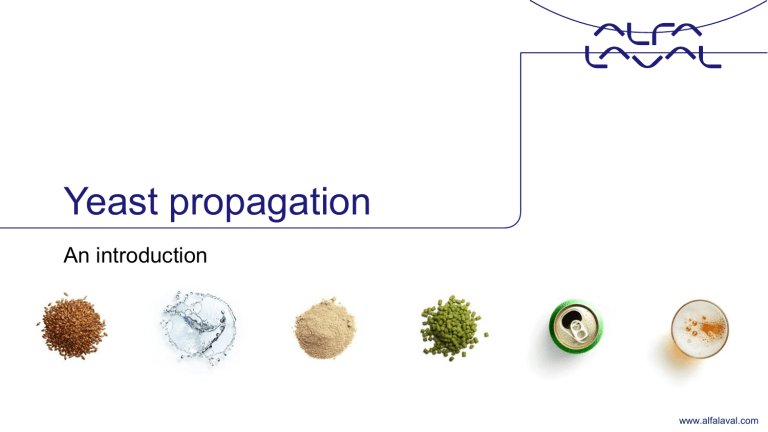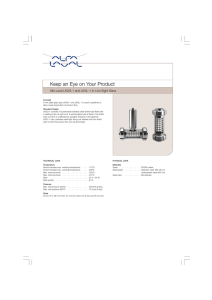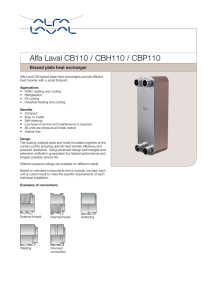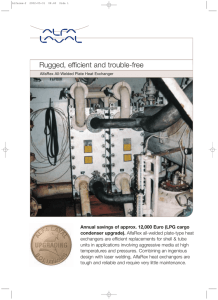
Yeast propagation An introduction www.alfalaval.com © Alfa Laval Yeast propagation What is yeast? It is a single-celled organism that belongs to the fungus kingdom It multiplies through cell division or ‘budding’ It is aerobic and anaerobic, so it is able to live with and without oxygen It undergoes anaerobic reactions when deprived of oxygen and produces alcohol © Alfa Laval Slide 2 www.alfalaval.com © Alfa Laval Yeast in the brewery Yeast is the most important microorganism in the production of beer Yeast metabolizes sugar from wort, producing alcohol and carbon dioxide thereby turning wort into beer. It ferments beer and influences its character and flavor; however, there must be no oxygen present. In the presence of oxygen, yeast multiplies which is important for propagation and the baking industry. This can spoil the longterm stability of beer flavour and clarity. © Alfa Laval Slide 3 www.alfalaval.com © Alfa Laval Yeast propagation and storage What is propagation and what is storage? Yeast propagation New yeast is required from time to time, as old yeast becomes unable to produce good beer with age. Growing new yeast is called yeast propagation. Yeast storage After the yeast has been used to produce beer it should be stored in comfortable surroundings in order not to loose its ability to produce good beer next time. This is yeast storage. © Alfa Laval Slide 4 www.alfalaval.com Yeast management Yeast propagation Yeast cropping Yeast plant Propagation Carlsberg Flask Yeast screen Storage Dynapitch Yeast pitching Lobe pumps Cropping HSS Beer separation and recovery Rotary jet heads Cleaning Top tank systems Yeast and fermentation management CIP station Cleaning-in-place Yeast systems Propagation and storage Yeast storage Yeast pitching Beer recovery from cropped yeast Waste yeast handling Cleaning-in-Place plant © Alfa Laval Thermolyzer Yeast autolyzation Coolers Yeast and beer cooling www.alfalaval.com © Alfa Laval Five breweries produce 50% of the world’s beer today © Alfa Laval Slide 6 www.alfalaval.com © Alfa Laval Designed for the future Bottom-fermented lager strains Top-fermented ale strains Rehydration of dried yeast Yeast inoculation from Carlsberg Flask Yeast inoculation from re-hydrator Craft brewers combine propagation and storage © Alfa Laval www.alfalaval.com © Alfa Laval Respiration in the yeast cell C6H12O6 (glucose) + 6O2 ≥ 6CO2 + 6H2O Energy gain: 28 moles of ATP per mole of monosaccharide Energy conservation: 29% Heat loss: 71% Yield factor: 0.54 g dry solids yeast per g carbohydrate = 54% © Alfa Laval www.alfalaval.com © Alfa Laval Fermentation in the yeast cell C6H12O6 (glucose) ≥ 2CO2 + 2C2H5OH (ethanol) Energy gain: 2 mole of ATP per mole of monosaccharide Energy conservation: 26% Heat loss: 74% Yield factor: 0.075 g dry solids yeast per g carbohydrate = 7.5% © Alfa Laval www.alfalaval.com Crabtree effect versus Pasteur effect Crabtree effect The inhibiting effect of respiration, or the use of oxygen, caused by the presence of certain carbohydrates in concentrations above certain levels. The yeast will not use oxygen when there is an abundant supply of food. Pasteur effect The inhibiting effect of oxygen on the process of fermentation. Yeast will use oxygen, when available, to better utilize the food available. © Alfa Laval Slide 10 www.alfalaval.com Yeast propagation to increase cell numbers © Alfa Laval www.alfalaval.com © Alfa Laval How much will yeast grow in a propagator? Typical cell numbers at the end of logarithmic growth: Lager strains: 80–120 million cells/ml Ale strains: 150–200 million cells/ml Aerobic growth: Max. 40 million cells/ml per degree Plato consumed Definition of “end of logarithmic growth”: Less than 20 million cells/ml per degree Plato consumed Anaerobic growth (Balling’s formula): About 14 million cells/ml per degree Plato consumed (at 40 million cells/ml = 1 g dry matter/litre) © Alfa Laval www.alfalaval.com © Alfa Laval What will stress the yeast ? Stress factors affecting yeast vitality, reproductivity and fermentation capability Shear and turbulent forces Oxidative stress Carbon dioxide toxicity Alcohol toxicity © Alfa Laval www.alfalaval.com Aeration equipment © Alfa Laval www.alfalaval.com © Alfa Laval Yeast mixing and aeration Yeast agitator and Cleaning-in-Place (CIP) system For propagation and storage plants With aeration or acid washing facility Scandi Brew® agitator © Alfa Laval www.alfalaval.com © Alfa Laval Agitator Off centre Mixing Aeration/acid wash CIP Mixing © Alfa Laval Aeration/acid washing Cleaning Slide 16 www.alfalaval.com © Alfa Laval Agitator or pump circulation loop? Agitation mixing more effectively Our agitator homogenizes the tank (100 hl) within 60–120 seconds with a 2.2 kW motor whilst a repumping loop with an 11 kW motor circulates at a flow rate of 700 hl/h This test clearly shows how little effect a repumping loop has on tank mixing We can conclude that our agitator provides more effective tank mixing than the repumping loop © Alfa Laval Slide 17 www.alfalaval.com © Alfa Laval Aeration © Alfa Laval Slide 18 www.alfalaval.com © Alfa Laval CIP test with cold water at 3 bar © Alfa Laval Slide 19 www.alfalaval.com 3-in-1 agitator Gentle agitation High vitality No stratification ≥ 99% viability In-tank process 100% sterile conditions Homogeneous after one minute of agitation 100% hygienic Steam sterilized © Alfa Laval Slide 20 www.alfalaval.com Pump circulation loop Low viability (≥ 95 %) High shear stress Stressed yeast Stratification Low vitality Cleanability Venturi pipe High power consumption Slide 21 © Alfa Laval www.alfalaval.com Comparison 3-in-1 agitator Pump circulation loop Gentle agitation High shear stress No stratification Stratification In-tank process Cleanability Homogeneous after one minute Venturi pipe 100% hygienic High power consumption Steam sterilized Low power consumption © Alfa Laval Slide 22 www.alfalaval.com Why a 3-in-1 agitator versus a pump circulation loop? 3-in-1 agitator Pump circulation loop ≥ 99% viability Low viability (≥ 95 %) High vitality Stressed yeast 100% sterile conditions Low vitality © Alfa Laval Slide 23 www.alfalaval.com © Alfa Laval Total cost of ownership: Agitators versus repumping /kW 2.2 kW 99% homogenized in 1–2 minutes © Alfa Laval 11 kW 99% homogenized in 1–2 hours Slide 24 www.alfalaval.com © Alfa Laval Stress factors: agitator test for propagation plant Viability methylene blue and acridine orange: Dead cells < 1% Proteinase activity: No detectable proteinase activity Concentration of medium-chain fatty acids: No correlation with agitator speed Carbon dioxide concentration: Less than 1 g/l © Alfa Laval Slide 25 www.alfalaval.com Yeast vitality / viability Yeast vitality Define the health of your yeast Yeast viability Define the number of living cells Measuring yeast vitality is very difficult (intracellular pH measurement). Only very few labs in the world can do so. Measuring if cells are dead or alive, or if cells have the ability to divide or grow. Yeast vitality can be evaluated in the fermentative capacity. Stressed yeast with low vitality leads to: Method of measuring methylene blue or acridine orange: Viability of fresh propagated yeast ≥ 99% Longer lag phase Slow extract utilization and slow fermentation © Alfa Laval Slide 26 Cropped yeast ≥ 97% www.alfalaval.com Propagation equipment © Alfa Laval www.alfalaval.com © Alfa Laval Carlsberg Flask Since the first single yeast cell was isolated at Carlsberg Laboratories, propagation has begun in the laboratory The last step before the propagation plant is the Carlsberg Flask In the Carlsberg Flask, wort can be sterilized, inoculated and transferred out again under sterile conditions © Alfa Laval Slide 28 www.alfalaval.com Function of the Carlsberg Flask Operation range Net volume 25 l (6.6 gal) Total volume 33 l (8.7 gal) Recommended transfer pressure Allowable pressure PS © © Alfa AlfaLaval Laval Slide 29 2–3 bar (29–44 psi) 6 bar (87 psi) www.alfalaval.com © Alfa Laval Single or multiple vessel plants Batch production in a single vessel in a yeast propagation plant Continuous production in a multiple vessel in yeast propagation plant Choice depends on propagation philosophy, frequency and investment Cell counts are typically about 100 million/ml (sometimes higher for ale strains) Difference in laboratory work © Alfa Laval Slide 30 www.alfalaval.com © Alfa Laval Wort sterilization Flush and steam © Alfa Laval Slide 31 www.alfalaval.com Wort cooling Flush and steam © © Alfa AlfaLaval Laval Slide 32 www.alfalaval.com Aeration and inoculation Carlsberg Flask Flush and steam © © Alfa AlfaLaval Laval Slide 33 www.alfalaval.com © Alfa Laval Propagation and sterilization Propagation in yeast propagation vessel 1 Sterilization of yeast propagation vessel 2 Flush and steam © Alfa Laval Slide 34 www.alfalaval.com © Alfa Laval Propagation and cooling Propagation in yeast propagation vessel 1 Cooling of yeast propagation vessel 2 Flush and steam © Alfa Laval Slide 35 www.alfalaval.com © Alfa Laval Transfer of yeast 1 Transfer of yeast propagation vessel 1 to yeast propagation vessel 2 CIP of yeast propagation vessel 1 – Propagation in yeast propagation vessel 2 CIP and steam Flush and steam © Alfa Laval Slide 36 www.alfalaval.com © Alfa Laval Transfer of yeast 2 Transfer of yeast from yeast propagation vessel 2 to yeast propagation vessel 1 The rest of yeast propagation vessel to fermenter CIP and steam Flush and steam © Alfa Laval Slide 37 www.alfalaval.com © Alfa Laval Wort sterilization Yeast propagation vessel 2 Flush and steam © Alfa Laval Slide 38 www.alfalaval.com © Alfa Laval Wort cooling Yeast propagation vessel 2 Flush and steam © Alfa Laval Slide 39 www.alfalaval.com © Alfa Laval Inoculation Inoculation from yeast propagation vessel 1 to yeast propagation vessel 2 Propagation in yeast propagation vessel 2 CIP and steam Flush and steam © Alfa Laval Slide 40 www.alfalaval.com © Alfa Laval Yeast propagation plant Special features of Alfa Laval Scandi Brew® plant Separate heating and cooling jackets on all vessels Possibility for in-vessel sterilization of wort All process and sterile air pipes and valves must be easily cleanable and designed for steam sterilization Aeration facility must be fully integrated in the CIP and sterilization system © Alfa Laval Slide 41 www.alfalaval.com © Alfa Laval Yeast propagation plant Special design features of Alfa Laval Scandi Brew® Special outlet valve with no dead space Automatic controlled pressure regulation Unique aeration control Unique top plate design – 100% CIP-able Sterilizable aeration aggregate/CIP system for improved plant efficiency, depending on the tank volume © Alfa Laval Slide 42 www.alfalaval.com © Alfa Laval Modular design Easy installation Short commissioning Well-proven technology Optimized tanks Comprehensive documentation − User manual − Commissioning reports − Drawings − Recommended list of spare parts − Maintenance manual © Alfa Laval Slide 43 www.alfalaval.com © Alfa Laval Yeast propagation Request for quotation © Alfa Laval Slide 44 www.alfalaval.com Contact us Henning and our global sales team are delighted to help you with your yeast management needs. Let us help you by contacting us here. © Alfa Laval Slide 45 www.alfalaval.com More information Yeast management systems Yeast cooler Yeast propagation plant Aeropitch Dynapitch Beer production Commercial brewing Craft brewing © Alfa Laval www.alfalaval.com




